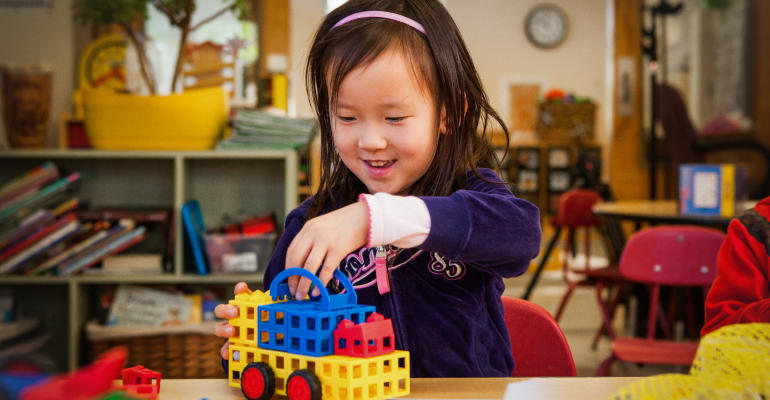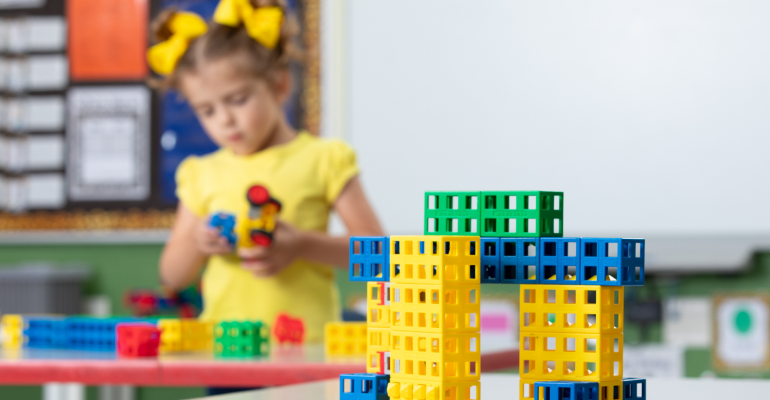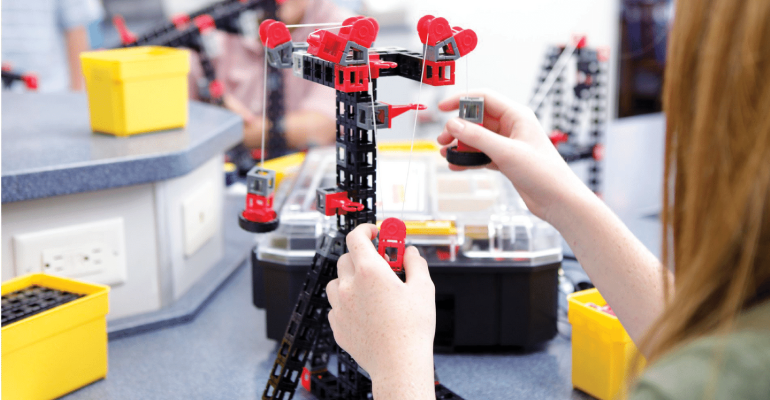
What is the difference between STEM kits for home use and STEM kits designed for the classroom? Learn all about classroom STEM kits and how to bring them to your students.
STEM awareness has grown in recent years, which is awesome news for expanding STEM education and closing the equity gap in access to STEM education. However, it also means that there is a lot of information about how to introduce STEM to the classroom and which tools to use.
That’s why we’ve created this comprehensive guide to help narrow down the most important information on STEM classroom kits. In this article, we’ll answer some of the most common questions we see online, like:
- What are STEM kits?
- What is the difference between STEM kits and STEM kits specifically designed for the classroom?
- What makes a good STEM kit for the classroom?
- How can I get a STEM kit for my classroom?
As a 501(c)(3) nonprofit organization, it’s our mission to provide equitable access to STEM education and that includes providing quality information to those looking for classroom resources for STEM education. Here you’ll find the answers to these questions and more to provide all the information you need on classroom STEM kits.
What are STEM kits?
STEM kits are learning kits complete with instructions, tools, and materials for learners to develop their STEM skills through structured educational activities. These kits can range from singular modeling activities (like building kits or science experiment kits) to modular kits with multiple activities using the same set of materials at home.

What are STEM Classroom Kits?
When created for the formal education setting, classroom STEM kits are powerful teaching tools with structured curricula, activities, and materials to build students’ understanding of science, technology, engineering, and mathematics.
Oftentimes, these kits provide more tools and resources for educators and students alike, reusable materials to be used for multiple grades, multiple years, and for numerous activities. They each fit into a comprehensive curriculum plan and support educational standards such as the Next Generation Science Standards (NGSS) for K-12 education (more on that here).
The STEM classroom programs at Kid Spark Education do all of the above and offer both convergent and divergent learning opportunities for students from Pre-K through 8th Grade, and we’ve found that these comprehensive STEM classroom kits best serve the diverse needs of each classroom.
Convergent and Divergent Learning
Convergent learning is what we commonly think of when discussing traditional education. It includes formal instruction and memorizing facts, concepts, rules, and structures that often serve as landmarks in their education by its measurement of having one correct answer to a problem. These are the types of things we measure in standardized tests and unit assessments. But the range of convergent learning and thinking is vast and includes much more than acquiring a shallow understanding of concepts.
In STEM education, convergent learning is what helps students understand how and why things work. This understanding helps them apply their knowledge to replicate results in other areas to solve new problems. From convergent learning emerges critical thinking, reasoning, logic, and problem-solving—all key components of STEM education.
Divergent learning involves the creative application of knowledge. It includes free play, exploration, creative challenges, and experimentation—or solving problems with multiple unique solutions. Divergent learning often occurs through hands-on activities like those in STEM classroom kits: building and engineering, programming robots, or creating new designs and applications.
It’s the combination of convergent and divergent learning that allows students to engage with the world around them through curiosity, analyze new challenges with critical thinking, and create new solutions by combining all the knowledge they’ve gained from instruction and activities.
STEM classroom kits provide a balance of structured curriculum for convergent learning and hands-on activities for divergent learning, but the combinations and ratios of these two core elements can vary greatly.

What is included in a STEM classroom kit?
Classroom STEM kits most commonly include the following:
- Curriculum Tools
These include formal curriculum resources such as reading materials for students, worksheets, unit assessments, and printed instructions for activities included in the STEM kit.
These resources might work independently for each lesson or fit into a larger scheme or structure encompassing multiple grade levels or learning levels.
Kid Spark Education's STEM classroom kits are designed for progressive learning. That means each classroom kit includes multiple lessons that continually build on prior knowledge and prepare students for the next level of instruction. Our programs are designed for students from Pre-K through 8th grade with both convergent and divergent learning in mind and curriculum tools such as printed lesson plans, student worksheets, unit overviews, and unit assessments.
This structured curriculum and its corresponding tools equip both students and teachers with a comprehensive learning experience for STEM skills to flourish.
- Instructional Tools/Guides
In addition to student-facing curriculum tools, classroom STEM kits often have instruction guides for educators as well. These might include teacher guides on how to lead STEM activities, unit assessment keys, complete lesson plans, and educator resources to help teachers instruct STEM confidently.
Research has shown that subtle biases in how STEM is instructed can deeply impact the confidence students have in their own STEM abilities. That’s why we firmly believe in supporting educators to become empowered STEM mentors for their students, including giving teachers the tools they need to succeed.
Our STEM classroom kits include instructional resources and tools for teachers to familiarize themselves with the concepts and lessons they will teach and ask engaging questions to encourage convergent and divergent learning.
- STEM Activities
So much of STEM is about hands-on learning experiences of exploration, discovery, and experimentation. That’s why STEM activities are at the heart of many STEM kits designed for the classroom.
The depth of instruction and connection to curriculum concepts varies between different STEM kits, but at Kid Spark, we include numerous hands-on lesson plans, activities, and creative challenges in each classroom STEM kit while using the same reusable materials.
Hands-on learning is essential to gaining a deep understanding of STEM concepts. These activities allow students to experiment with new ideas, apply new concepts creatively, and see how the elements of STEM apply to the physical world around them.
- Reusable Materials
Making an investment in STEM classroom kits is a great step toward building passionate STEM leaders, and the reusable materials within these kits make the investment even more worthwhile.
Because so many educators carry the burden of supplying their own classroom supplies for hands-on activities, the reusable materials within STEM classroom kits are a welcome feature. These kits allow teachers to use the same materials year after year and for some kits (like ours) for lesson after lesson.
With this functionality and versatility, teachers can feel confident that their investment is worthwhile for all the lessons, activities, and years of use they can get from a single classroom STEM kit.

Other STEM classroom kits (like those by Kid Spark Education) offer additional elements to support STEM education in the classroom, such as:
- Educator Training & Professional Development Resources
In addition to the instructional support materials we offer within each classroom STEM kit, Kid Spark Education offers a full online library of professional development courses for teachers.
With STEM rapidly advancing every year with new technologies and discoveries, we know how important it is to feel confident in the subjects you’re teaching. Our digital library provides educators with the resources they need to build their own confidence in STEM concepts, in teaching STEM, and in becoming powerful STEM mentors for the next generation.
- Creative Challenge Activities
In addition to the structured lesson plans and hands-on activities supplied in our classroom STEM kits, we also provide additional design challenges for students to experiment with their newfound STEM skills even more.
These highly-structured design challenges allow students to flex their creative problem-solving muscles and apply their STEM understanding in fun and engaging ways.
- Curriculum Support
Each Kid Spark STEM kit fits into a larger progressive curriculum from Pre-K through eighth grade. By introducing students to STEM concepts progressively, students gain the foundational fluencies they need to accelerate their educational success while educators are relieved of the pressure to design, furnish, and instruct their own lesson plans while keeping students of all levels engaged and challenged.
Kid Spark STEM kits also provide flexible teaching tools to engage students of all abilities. Adaptations, creative challenges, and additional instruction tools help educators provide high-quality STEM instruction for their diverse students.
STEM Kits for Pre-K, Elementary, and Middle School Classrooms
While many focus on the importance of K-12 STEM education, studies (like this one featured in the International Research in Early Childhood Education Journal) show that introducing STEM before kindergarten engages young learners and supports a lifelong journey of STEM education. STEM classroom kits that start at the Pre-K level build upon young students’ capacity for creativity, observational skills, and curiosity.
At Kid Spark Education, we believe all students should have access to STEM education as early as possible. So our classroom STEM kits start at Pre-Kindergarten and progressively instruct students through age and grade-appropriate curricula through eighth grade. In those nine years of classroom instruction, our STEM kits cover the basic building blocks of STEM fluency and gradually introduce more advanced subjects such as complex engineering, computer science and coding, robotics, and more.
Here’s an inside look into Kid Spark Education’s STEM classroom kits:
Grades Pre-K–1st
Our Foundational Fluencies Lab gives young students their first introduction to the world of STEM. Here, students learn the fundamental building blocks of STEM on which they can build for the next several years of their education.
Lessons are designed to help develop the core understanding of spatial reasoning, sequence and correspondence, and creative problem-solving through fun learning activities and instruction. This introductory curriculum keeps STEM accessible so that students of all levels can equally engage and practice their skills through collaborative learning experiences.
Learn more about our Pre-K–1st Grade STEM Program, here.
Grades 2–5
Students from second through fifth grade advanced the core STEM concepts introduced in the Foundational Fluences Lab and are introduced to new ways to apply their STEM knowledge to solve problems and create solutions.
The 2nd–5th grade STEM program provides instruction on mechanisms and movement, applied mathematics, robotics and coding, and more. Each unit of instruction includes multiple lesson plans, activities, and creative challenges. Each STEM classroom kit comes equipped with all the reusable engineering, articulating, and robotic components needed for instruction, along with comprehensive curriculum tools for both teachers and students.
Learn more about our 2nd–5th Grade STEM Program, here.
Grades 6–8
STEM classroom kits for middle school are designed to be accessible, challenging, and exciting for students of all levels. With a broad range of technologies and scientific subjects, Kid Spark’s STEM Pathways Lab for grades 6–8 covers simple and compound machines, rapid prototyping, 3D printing, loops and variables, integrated engineering, and more advanced robotics.
Lessons and activities are designed for students to engage in many hands-on activities and solve new challenges through creative problem-solving and critical thinking. Combining everything they’ve learned from Kid Spark’s progressive curriculum, students can create complex components and advanced programming solutions in middle school—empowering them for a bright future in their STEM education and beyond.
Learn more about our 6th–8th Grade STEM program here.

How to Get STEM Classroom Kits for Your Students
If you’re ready to bring classroom STEM kits to your school but aren’t sure where to start, here are a few ways to jumpstart the process:
1. Purchase STEM programs at Kid Spark Education
Get started right away by purchasing program materials here.
STEM programs are divided by grade level and serve 2-4 students per lab kit. By purchasing a program, you receive an all-in-one solution with the curriculum, instruction, online resources, and reusable materials for numerous units of instruction, lesson plans, and activities.
2. Get the support of your administration
Sometimes, curriculum budgets and district regulations make it a little more difficult to bring STEM kits into the classroom. That’s where the support of the administration can help.
Administrators might first start by offering a STEM enrichment program with our classroom STEM kits to introduce the curriculum and allocate funding more easily, or starting first with a school-sponsored After-School STEM program.
However your administration seeks to bring STEM kits to the classroom, you can advocate for your student’s STEM education by including administration and introducing them to all-in-one multi-grade level solutions like Kid Spark’s.
3. Find additional funding
At Kid Spark Education, we believe that STEM should be accessible to students of all ages and backgrounds. Unfortunately, students of color, students from low-income households, and students in rural communities are most affected by STEM education inequities. This makes bridging the gap to these communities even more essential to introduce STEM as early as possible.
For additional funding, see if your school qualifies for federal EANS funding. If you’re not familiar with this program, here’s a guide on everything you need to know about EANS funding and how to see if your school qualifies.
You can also apply for the Kid Spark Education STEM Equity Grants Program if you are a public school in the U.S. serving a high percentage of Title 1 students.
Ready to Get Started with Kid Spark?
Bringing classroom STEM kits to your students is an exciting journey, and we’d love to help guide you through the process.
Connect with us today to plan your program and ensure a robust and effective STEM program for your students.
.png?width=1270&height=453&name=Copy%20of%20Kid%20Spark%20Logo%20(Horizontal%20-%20Full%20Color).png)